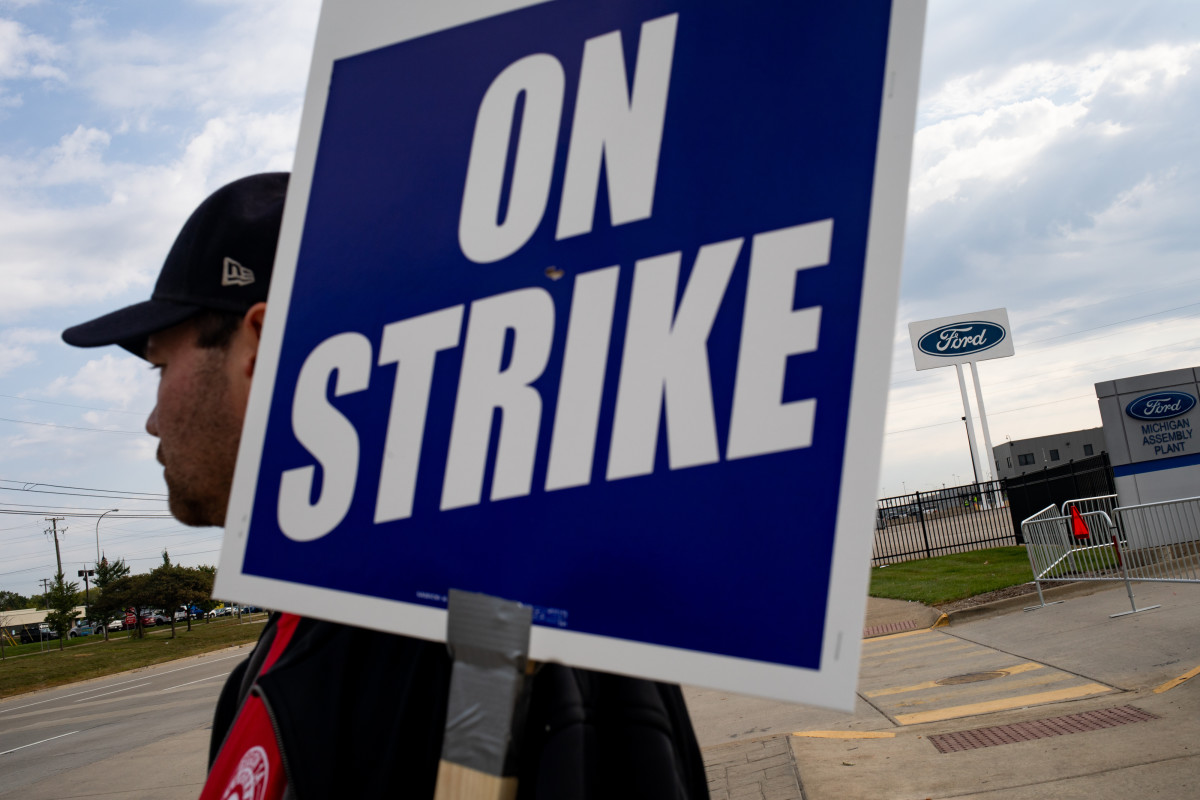
Following record automaker profits the past year, workers are demanding a record contract from General Motors (GM) -), Ford Motors (F) -), and Stellantis (STLA) -), which owns Jeep, Chrysler, and Dodge.
Striking workers' wish list includes reversing concessions made during the Great Recession, increasing pay, shorter work weeks, and offsetting inflation with annual cost-of-living raises.
So far, offers from Detroit's big three have failed to win United Auto Workers' support, including General Motors' latest offer, which included pay raises, a faster pathway to top hourly earnings, more money for retirement, and other concessions.
An inability to find common ground comes at a steep cost. General Motors reportedly lost $200 million in the first two weeks of the UAW strike, and all three companies have announced layoffs that will likely strain union members' wallets.

Auto workers deploy a unique strike strategy
The typical union strike playbook involves striking against one company at a time and then leveraging whatever agreement is struck with other companies. This game plan has historically worked, including during recent negotiations between striking pilots and major airlines.
For example, the American Pilots Association secured a contract with Delta Air Lines (DAL) -) in March, increasing pay by 34% by 2026. That gave it additional leverage to negotiate a 40% increase over the next four years from United Air (UAL) -) in July and a 41% increase in August at American Airlines (AAL) -).
Related: Ford delivers tough-luck news for UAW workers
The UAW is taking a different "stand-up" strike approach. Instead of striking at every facility all at once, local members are asked to "stand up" and strike at specific locations. This allows the union to maximize its leverage by enabling it to strike at increasingly more important facilities as time passes.
The UAW's approach is also a bit unique in that instead of focusing on one company at a time, it decided to strike at General Motors, Ford Motor, and Stellantis simultaneously.
We've already seen the UAW's strike expand. Initially, 13,000 workers at plants in Michigan, Ohio, and Missouri went on strike on Sept. 15. They were joined by 5,600 General Motors and Stellantis workers at 38 part-distribution plants on Sept. 22, and 7,000 Ford and General Motors workers on Sept 29.
Auto workers reject General Motors' latest offer
The disruption to production is already being felt throughout supply chains at the big three automakers. As a result, General Motors, Ford Motor, and Stellantis have laid off about 5,000 workers at plants producing components that have seen demand shrink because of the strike.
General Motors' latest offer to workers provided significantly more pay and benefits to get production back on track.
Specifically, GM offered a 20% pay increase, including a 10% increase in year one, a reinstatement of COLA inflation adjustments for workers at the top-wage tier beginning in year two, no change in its healthcare costs, a halving in the time required to reach its top wage tier to four years, a bump in temporary worker pay to $20 per hour, and an increase in 401(k) retirement contributions to 8% from 6.4%.
While that offer seems compelling, it is shy of UAW workers' demands. The UAW wants a 40% pay increase, a 32-hour work week, the elimination of pay tiers, cost-of-living increases for everyone, and a return to the pension system that was dismantled during the Great Financial Crisis when General Motors declared bankruptcy.
The car companies have said that's too much because it would put them at a disadvantage to compete with the likes of Tesla (TSLA) -), Toyota Motor (TM) -), and Honda Motor (HMC) -) at a critical moment for the industry.
Electric vehicle adoption is soaring, and the big three are investing billions to catch up to pioneers, including Tesla, who aren't as hamstrung by legacy fixed costs and union wages.
More Business of EVs:
- A full list of EVs and hybrids that qualify for federal tax credits
- Here’s why EV experts are flaming Joe Biden’s car policy
- The EV industry is facing an unusual new problem
EVs represented approximately 7% of total vehicle sales in the U.S. in the second quarter. Wall Street analysts believe they'll account for about one in four vehicle sales by 2026.
"Our competitors across the country and around the world, most of whom are non-union, will waste no time seizing the opportunity we would be handing them," wrote General Motors' President Mark Reuss in September.
The UAW counters that there's plenty of money to go around.
"GM has spent more than $21 billion on stock buybacks over the last decade, lavishing Wall Street with the results of our labor. That's not right," responded UAW Vice President Mike Booth.
Forget General Motors – Sign up to see what stocks we’re buying now







